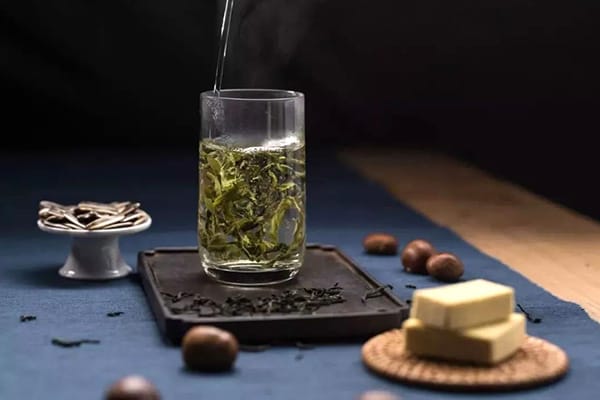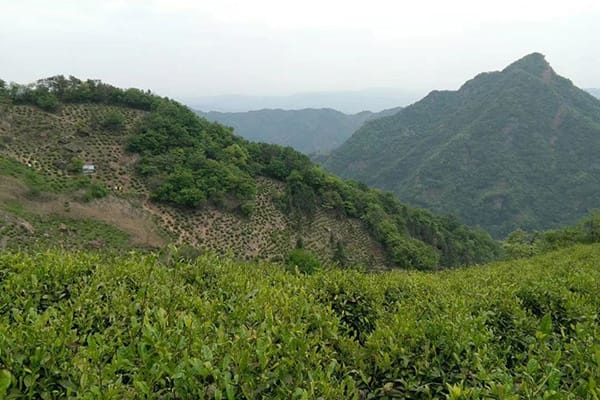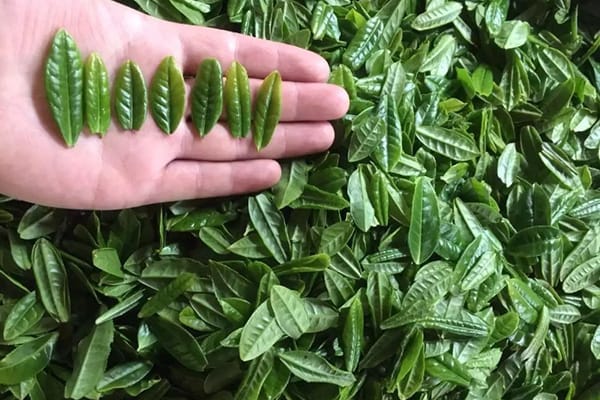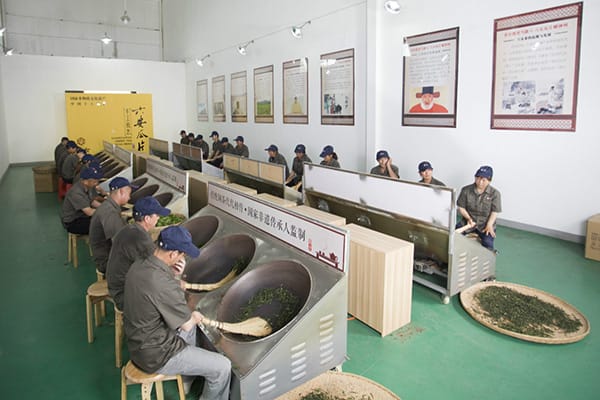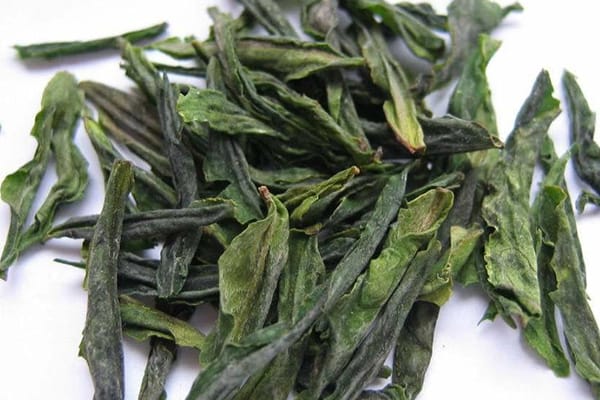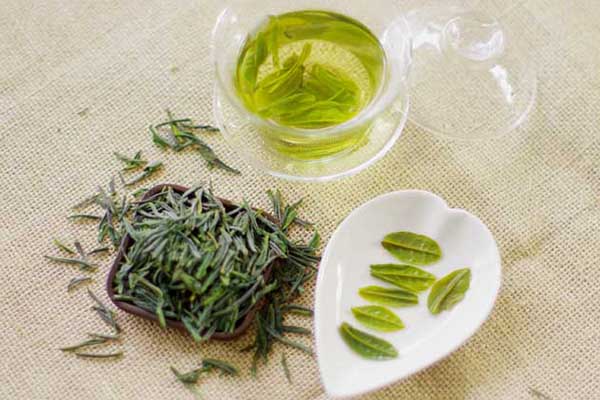Last Updated on 05/23/2021 by Desmond
You may hear about a tea with a strange name – Lu’an Melon Seed tea. Does anyone really make tea with melon seeds? Of course not. Actually, its real name is Lu’an Gua Pian tea, which is a famous green tea. And its appearance and processing are indeed unique.
CONTENT
What Is Lu’an Gua Pian Tea
Lu’an Gua Pian tea is originated in Lu’an, Anhui, also called Lu’an Melon Seed tea or Pian Cha. Among all teas, it is regarded as the most complex one because of the short harvest time and the elaborate processing. Its source leaves only pick the particular second leaf, and it’s the only loose tea without stems and buds.
Looks like the dried tobacco leaf, Lu’an Gua Pian tea shows a dark-green color. When it was still fresh, leaves are flat, complete, and almost at the same size, look like the melon seed (a Chinese and Russian traditional snack,) so it got the name.
History
Anhui is a well-known tea-producing region of China; Huoshan Huangya(yellow tea) and Taiping Houkui(green tea) are both originated there. It’s hard to confirm when Lu’an Gua Pian’s birth in history. According to the record in The Classic of Tea, teas produced here were called Lu’an Tea initially. Still, it’s not only referring to the Gua Pian. About the origin stories, there are two versions:
One story is, probably in 1905, a local tea merchant had a whim. He elected all the leaves at the same size from the tea he purchased, removed all the stems, then sold them as a new high-grade green tea, and he made succeed.
One competitor heard this news, then he hired workers, duplicated this idea, and named the product “Feng Chi.” Another competitor did more; he direct screened the leaves started at the picking process and optimized the processing methods, making out a more high-quality product. Thus, all the local tea masters began to study this way, and Lu’an Gua Pian tea birthed.
The other story is that in the early Republic of China, a squire wanted to please Yuan Shikai, the big warlord. He asked the Lu’an tea masters to produce a kind of green tea, which only uses the best source leaves. So the Lu’an Gua Pian was invented.
Some history experts surmise that Lu’an Gua Pian tea’s birth maybe earlier. It comes from a top-grade of Lu’an tea – Qishan Yunwu Gua Pian tea. It was a tribute of the Qing royal; it must be provided about 0.5kg to the Empress Dowager Cixi every month. At that time, it was a tea that only the one who has a high social status can consume.
After the new China founding, Lu’an Gua Pian tea became many government leader’s favorites. In 1959, Lu’an Gua Pian was listed as one of the Chinese 10 famous teas. When the U.S. Secretary of State Henry Kissinger visited China in 1971, Lu’an Gua Pian tea was presented as a national gift. That made its social status and value increase significantly.
Producing Regions
Lu’an Gua Pian tea plantations are primarily distributed in Lu’an, Jinzhai, Huoshan around the Dabie Mountain. They’re at a low altitude(100-300m). Still, the climate here is cold, rainy, and long-time sunshine, which is suitable for the growing and nutrient accumulation of the tea trees.
It was said, Lu’an Gua Pian was the earliest came from the Qiyun Mountain in Jinzhai country, so it is also called Qiyun Gua Pian. There is a bat cave at the south hillside; several tea trees grow at the entrance. Many bats living in the cave, the poo provides great and enough nutrients to the tea trees, make them growing strong. Those several tea trees are regarded as the Lu’an Gua Pian’s mother trees, and their products are honored as the best.
Camellia Sinensis Varieties
There are 3 main types of Camellia Sinensis growing in the plantations, provides source leaves for producing Lu’an Gua Pian tea.
The Native Species Old Tea Trees. The authentic Lu’an Gua Pian tea is made from the native species Camellia Sinensis; they are small or middle-leaf type, the local people called them “Ben Cha,” and many of them have been 100 years old. These old tea trees are rare, and their budding late, hard to satisfy the market need. So tea plantations introduced other types of tea trees.
Wuniu Zao Species. This type of tea tree is cultivated out in recent years. It is budding early and can be said that it provides leaves for the Mingqian Cha production in a specialty.
Salix-leaf type. It was introduced to Anhui in the 1980s, a purpose for increasing the yield. This tea tree is named because of the salix-leaf-like leaves.
The Complicated Processing
Why the Lu’an Gua Pian tea looks so strange? It’s because of its unique and complicated processing. The processing of Lu’an Gua Pian tea is much complex than other green teas, and some steps can be said are full of theatricality.
Picking
Shortly after the Chinese New Year Festival, tea farmers begin to prepare tea leaves picking. Lu’an Gua Pian’s picking standard is different from other teas; it is sorted by the leaf growth sequence.
The new buds will shoot at the end of March and grow into the first leaf at the beginning of April. The second leaf comes in early April, and the third comes in the midmonth. The fourth leaf shoots in at about 20th, which the day called Guyu. At this time, the tea farmers will pick up the second leaf.
They think that this second leaf, also the third on the branch, is rich in nutrition and has an excellent fresh degree. 1-2 days after picking it, the leaf comes third, also growing into the second position; tea farmers will start a new round of picking.
The best harvest time of Lu’an melon seed tea is ten days before or after Guyu. Once May comes, the temperature getting high and the leaves growing old, and the quality gets worse.
Screening
After the fresh leaves picking, tea farmers will screen them first, pick out the second leaves, which up to standard. The left tea stems and other leaves will be made into the by-products.
Fixation
As a green tea, Lu’an Gua Pian hadn’t been fermented during processing; the natural fermenting must be stopped by a step called Fixation. And this processing is also called “Flame Work,” it’s very complex and essential. Just like the Xinyang Maojian tea, it will take two parts.
The first frying is called “Raw Pan.” Tea masters will put the leaves in an 80cm diameter pan, frying them at a temperature of 100-120℃. Unlike other teas frying with hands or machines, when tea masters frying Lu’an Gua Pian tea, they will use a small thin bamboo sticks-made broom. Leaves keep rotating and tossing, which looks like when frying rice.
After 1-2 minutes, leaves will be transferred to another pan for the second frying, at a temperature of 70-80℃. This time, except frying, tea masters will also flap the leaves with the broom, making them flat. It also replaces the rolling step in common tea-processing. And this step is also called “Cooked Pan.”
After the fixation, the leaves’ water content will reduce to under 35%.
Drying
The following is the most important roast-drying job, and it’s also with a great character; it determines the mouthfeel and flavor of Lu’an Gua Pian tea. The drying process has 3 steps: first roast, re-roast, and final roast.
The first roast is also called “Pull the Rough Fire.” Leaves will be put in a bamboo cage for roasting, and the fuel must be the best, and smokeless chestnut tree carbon makes no smoky smell on the leaves. After this process, the leaves’ water content will reduce to about 20%.
The leaves after the first roast is the rough tea. Tea masters will finish the processing of it on the same day of picking. So when the harvest season comes, you can see many people selling the Lu’an Gua Pian rough tea in the bazaar in the evening. And the tea factories will perform two additional dryings after purchasing them.
Re-roast is also called “Small Fire.” It makes the leaves’ water content reduced to 10% under the same operation. After re-roast, leaves will be placed 3-5 days to let the left water in the vein equally full the leaf again, or the following roasting will burn the leaves.
The following is the final roast, which is also called “Pull the Old Fire.” This is the most important step, and it’s very ornamental. Setting a carbon furnace on the ground, burning a great flame; two tea masters for a team, carry the bamboo cage with leaves in, roasting on the fire for 1-2 seconds, then move away. This process will repeat over 100 times till the leaves’ water content is reduced to 6%. Hereto, Lu’an Gua Pian tea’s processing is finished.
Lu’an Gua Pian Tea Grades
Just like most Chinese teas, Lu’an Gua Pian tea will be graded according to the leaves’ position on the branch. Every grade got its own name.
Ti Pian
The specification of Lu’an Gua Pian tea is without any stems and buds. So the top-leaf on the branch, which is just bloom, is the tenderest. The tea made from this first leaf is called “Ti Pian,” which is in accord with most consumers’ demand for the tender tea.
Gua Pian
After the fourth leaf shoots on the branch, the tea masters pick up the second-old leaf and make it into tea. This leaf is not the tenderest, but tea masters thought it contains the richest nutrition and flavor, and it’s the best. The Lu’an Gua Pian tea made from this leaf is the most authentic.
Besides, according to the producing regions, Gua Pian tea is also classified into Neishan(inner mountain) Gua Pian and Waishan(outer mountain) Gua Pian.
The Neishan Gua Pian refers to the tea that originated in the Lu’an Gua Pian’s birthplace – Qiyun Mountain. It got a rare yield and hard to buy on the market. And the Waishan Gua Pian refers to the tea that originated in the other plantations in Lu’an; the quality is regarded not as good as the Neishan ones.
Mei Pian
After Guyu, the hot and rainy summer comes. Leaves are mature enough now, even a little rough and old. The tea made from the leaves picked during this period is called “Mei Pian.” It typically with a reasonable price, but the quality just so-so.
Lu’an Gua Pian Flavor
Lu’an Gua Pian’s dried leaves are integrity; both side edges are lightly curled into a strip, shows a dark-green color. If you scrutinize it, you will find that there is some white frost on the surface. It is said that these frosts are formed because of the unique “Pull the Old Fire” processing, which makes the tea polyphenols and caffeine in tea separate out and crystallized.
After brewing, leaves got moist and back to the origin melon seed shape. The infusion is yellow-green, sending a full aroma, a little like the orchid fragrance of Tieguanyin tea. Even though Lu’an Gua Pian has been roasted many times, it won’t get any smoky flavor due to the smokeless carbon but a delicate roasted-chestnut aroma.
Due to the source leaves are a little older and contain more tea polyphenols and caffeine, Lu’an Gua Pian tastes robust, brisk, and without any typical bitterness of green tea. After the infusion slip down your throat, the sweetness aftertaste will come soon, and the full fresh aroma will last in your mouth a long time. In past China, the nobles love having a cup of Lu’an Gua Pian tea after a noon break, helping refresh the brain and digest the lunch.
How To Make Lu’an Gua Pian Tea
Traditional Way
- Prepare and preheat a 200ml white ceramic Gaiwan;
- Put 3-5g Lu’an Gua Pian leaves in;
- Add 90℃ water in, cover, and steep for about 40 seconds;
- Pour the infusion in a fair cup to equal the concentration;
- Serve to each cup and enjoy;
Typically, the Lu’an Gua Pian leaves are integrity without fewer broken pieces; you can decide whether to wash the tea at the first brew. Besides, the source leaves are comparative maturity to make more brews than ordinary green tea. Some high-quality Lu’an Gua Pian can brew over ten rounds.
Simple Brewing with a Glass Cup
- Prepare and preheat a usual glass cup;
- Put 3-5g leaves in;
- Add 90℃ water, just to cover the leaves;
- Shake the cup gently, let the leaves moist enough;
- Keep fill in hot water, then steep for about 10 seconds;
- Enjoy;
Store Way
- Prepare an iron or a tin can, which with great airtightness;
- Make sure that the container and leaves are dry enough;
- Put the tea into the can and cover it tight;
- Wrap a kraft well outside the container to get a better airtightness;
- To store it at a dry enough place, where also under 20℃;
Related Reading: Choose the best tea storage container for loose leaf tea.
As a green tea, Lu’an Gua Pian is not suitable for long-time storage; it is recommended to finish consumed in 1-2 years.
